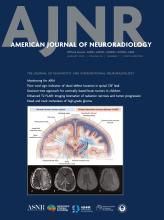Research ArticleNeuroimaging Physics/Functional Neuroimaging/CT and MRI Technology
Visualization of Intracranial Aneurysms Treated with Woven EndoBridge Devices Using Ultrashort TE MR Imaging
Daniel Toth, Stefan Sommer, Riccardo Ludovichetti, Markus Klarhoefer, Jawid Madjidyar, Patrick Thurner, Marco Piccirelli, Miklos Krepsuka, Tim Finkenstädt, Roman Guggenberger, Sebastian Winklhofer, Zsolt Kulcsar and Tilman Schubert
American Journal of Neuroradiology January 2025, 46 (1) 107-112; DOI: https://doi.org/10.3174/ajnr.A8401
Daniel Toth
aFrom the Department of Neuroradiology (D.T., R.L., J.M., P.T., M.P., M.K., T.F., S.W., Z.K., T.S.), Clinical Neuroscience Center, University Hospital Zurich, Zurich, Switzerland
Stefan Sommer
bSiemens Healthcare (S.S., M.K.), Zurich, Switzerland
cSwiss Center for Musculoskeletal Imaging (S.S.), Balgrist Campus, Zurich, Switzerland
dAdvanced Clinical Imaging Technology (S.S.), Siemens Healthcare, Lausanne, Switzerland
Riccardo Ludovichetti
aFrom the Department of Neuroradiology (D.T., R.L., J.M., P.T., M.P., M.K., T.F., S.W., Z.K., T.S.), Clinical Neuroscience Center, University Hospital Zurich, Zurich, Switzerland
Markus Klarhoefer
bSiemens Healthcare (S.S., M.K.), Zurich, Switzerland
Jawid Madjidyar
aFrom the Department of Neuroradiology (D.T., R.L., J.M., P.T., M.P., M.K., T.F., S.W., Z.K., T.S.), Clinical Neuroscience Center, University Hospital Zurich, Zurich, Switzerland
Patrick Thurner
aFrom the Department of Neuroradiology (D.T., R.L., J.M., P.T., M.P., M.K., T.F., S.W., Z.K., T.S.), Clinical Neuroscience Center, University Hospital Zurich, Zurich, Switzerland
Marco Piccirelli
aFrom the Department of Neuroradiology (D.T., R.L., J.M., P.T., M.P., M.K., T.F., S.W., Z.K., T.S.), Clinical Neuroscience Center, University Hospital Zurich, Zurich, Switzerland
Miklos Krepsuka
aFrom the Department of Neuroradiology (D.T., R.L., J.M., P.T., M.P., M.K., T.F., S.W., Z.K., T.S.), Clinical Neuroscience Center, University Hospital Zurich, Zurich, Switzerland
Tim Finkenstädt
aFrom the Department of Neuroradiology (D.T., R.L., J.M., P.T., M.P., M.K., T.F., S.W., Z.K., T.S.), Clinical Neuroscience Center, University Hospital Zurich, Zurich, Switzerland
eDepartment of Radiology (T.F., R.G.), University Hospital Zürich, Zürich, Switzerland
Roman Guggenberger
eDepartment of Radiology (T.F., R.G.), University Hospital Zürich, Zürich, Switzerland
Sebastian Winklhofer
aFrom the Department of Neuroradiology (D.T., R.L., J.M., P.T., M.P., M.K., T.F., S.W., Z.K., T.S.), Clinical Neuroscience Center, University Hospital Zurich, Zurich, Switzerland
Zsolt Kulcsar
aFrom the Department of Neuroradiology (D.T., R.L., J.M., P.T., M.P., M.K., T.F., S.W., Z.K., T.S.), Clinical Neuroscience Center, University Hospital Zurich, Zurich, Switzerland
Tilman Schubert
aFrom the Department of Neuroradiology (D.T., R.L., J.M., P.T., M.P., M.K., T.F., S.W., Z.K., T.S.), Clinical Neuroscience Center, University Hospital Zurich, Zurich, Switzerland

This article requires a subscription to view the full text. If you have a subscription you may use the login form below to view the article. Access to this article can also be purchased.
ASNR members
Login to the site using your ASNR member credentials
Log in using your username and password
Log in through your institution
You may be able to gain access using your login credentials for your institution. Contact your library if you do not have a username and password.
In this issue
American Journal of Neuroradiology
Vol. 46, Issue 1
1 Jan 2025
Advertisement
Daniel Toth, Stefan Sommer, Riccardo Ludovichetti, Markus Klarhoefer, Jawid Madjidyar, Patrick Thurner, Marco Piccirelli, Miklos Krepsuka, Tim Finkenstädt, Roman Guggenberger, Sebastian Winklhofer, Zsolt Kulcsar, Tilman Schubert
Visualization of Intracranial Aneurysms Treated with Woven EndoBridge Devices Using Ultrashort TE MR Imaging
American Journal of Neuroradiology Jan 2025, 46 (1) 107-112; DOI: 10.3174/ajnr.A8401
0 Responses
WEB Device for Aneurysm Imaging with UTE-MRI
Daniel Toth, Stefan Sommer, Riccardo Ludovichetti, Markus Klarhoefer, Jawid Madjidyar, Patrick Thurner, Marco Piccirelli, Miklos Krepsuka, Tim Finkenstädt, Roman Guggenberger, Sebastian Winklhofer, Zsolt Kulcsar, Tilman Schubert
American Journal of Neuroradiology Jan 2025, 46 (1) 107-112; DOI: 10.3174/ajnr.A8401
Jump to section
Related Articles
Cited By...
This article has not yet been cited by articles in journals that are participating in Crossref Cited-by Linking.
More in this TOC Section
Similar Articles
Advertisement











